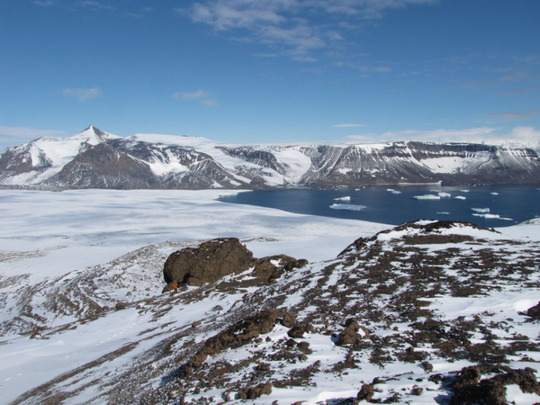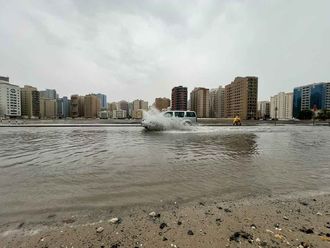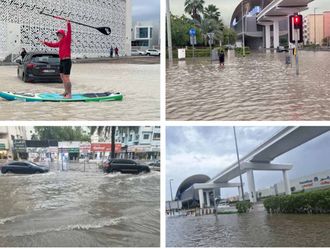
Let’s start with an understatement. There’s quite a bit of ice in Antarctica and if enough of it melted, it would make a real planetary mess. About three million years ago so much of Antarctica melted that, according to some studies, all that extra water pushed the oceans about 17 metres higher than they are today.
So understanding Antarctica and its smaller polar opposite in Greenland has gigantonourmously big implications for the future. These giants could reshape coastlines, swamp places currently occupied by hundreds of millions of people and make entire nations disappear.
Rising sea levels don’t just put places under water, but every centimetre increases the impacts that storm surges have on people, homes and coastal infrastructure.
In recent decades, Antarctica and Greenland have played minor roles in the world’s rising oceans. But this is changing. Between 1993 and 2010, according to studies assessed by the Intergovernmental Panel on Climate Change, seas are rising by about 3.2 millimetres a year — a rate that is accelerating. About a third of that annual rise comes from the warming oceans (warmer ocean water takes up more space).
The second biggest driver is the melting of glaciers around the world (outside of Greenland and Antarctica). The melting of ice sheets in Greenland and Antarctica only accounts for about one sixth of that 3.2 millimetre, but as we already know these ice sheets are like sleeping giants.
Two studies in April looked at Antarctica and suggest the giant is probably already awake. The first study (not that widely reported) was further confirmation that the melting of the West Antarctic ice sheet is accelerating (a study in May 2014 found the bits of the ice sheets attached to the land were on a “rapid retreat” and the following month another study reported satellite data showing an acceleration of the melt rate, now at 159 billion tonnes of ice per year).
The second study (not reported at all from what I can tell) tried to understand how Antarctica’s ice sheets behaved during the Pliocene — about three million years ago, when sea levels were likely about 20 metres higher than today.
The Pliocene is interesting because levels of carbon dioxide in the atmosphere were similar to today (400 parts per million in the atmosphere right now), with temperatures between 2°C and 3°C above where they were just before we kicked off the industrial revolution and started burning fossil fuels, loading the atmosphere with extra carbon dioxide.
The paper, published in the journal “Earth and Planetary Science Letters”, tried to work out how Antarctica’s ice sheets could have collapsed and how quickly it might have happened.
The scientists added two new processes to a computer model. They modelled how big chunks of ice fall off cliffs into the ocean and added a mechanism known as hydrofracturing (where melt water bleeds into small cracks in the ice, forcing open bigger cracks).
The results suggested that over the course of thousands of years Antarctica’s ice sheets were responsible for about 17 metres of sea level rise. But what about West Antarctica — the area already showing signs of instability and potential collapse? As the computer model ran, it took 100 years for the West Antarctic ice sheet to raise sea levels by about three metres.
The study also finds that the East Antarctic ice sheet (which is relatively stable right now compared to the West) would have contributed about 14 metres of sea level rise. Lead author Dr David Pollard, of the Earth and Environmental Systems Institute at Pennsylvania State University, and co-author Professor Robert DeConto, of the University of Massachusetts, told me while it was “pretty clear” that their findings had implications for the future (to be explored in an upcoming paper by Pollard and DeConto) the studies’ real focus was to better understand the past.
They said their paper was only a “preliminary exploration” and did not imply we’re in for three metres of sea level rise by the end of this century. They also said there were large uncertainties in their work.
Fellow co-author Professor Richard Alley, also of Pennsylvania State University, explained: “The unfortunate reality is that this is a difficult system to model, which fairly clearly exhibits threshold behaviour (or switching behaviour ... once a threshold is passed, the ice may switch to a new state rapidly with little chance of short-term reversal, and in West Antarctica, that will give a few meters of sea-level rise).
“Such systems are typically quite difficult to predict — exactly how hard do you have to push to flip a switch?”
I asked Alley about the implications from the study. He offered me an analogy. “A commuter expects traffic delays. The best possible trip has no traffic. The worst possible trip is being killed by a drunk driver or some similarly catastrophic outcome. What we expect ... what is most likely ... is on the ‘good’ side of what is possible.
“Many issues of climate change seem to have a similar distribution; we don’t see how raising carbon dioxide greatly and rapidly will turn the world into the Garden of Eden, but we do see many ways that it might break things we depend upon.
“As commuters, we spend a lot of money on air bags, antilock breaks, crumple zones, seat belts, child seats, traffic engineers, police, Mothers Against Drunk Driving, and other actions to minimise the dangers from events that we don’t expect to happen but that are possible. If the analogy is useful, it may have implications for wise actions.”
This, I reckon, is a polite way of saying we should be cutting emissions of greenhouse gases to avoid slamming the only vehicle we have into a concrete wall.
Australian scientist Dr John Church is one of the world’s leading experts on sea level rise (he’s been studying it for a couple of decades) and was a coordinating lead author of the relevant chapter in the latest IPCC report.
That chapter found that without cuts to greenhouse gas emissions, sea levels could rise as high as one metre from where they were a decade ago. This could happen within 70 years.
Church told me the most recent studies on Antarctica did not, in his view, suggest the IPCC estimates were too conservative (while saying he was seen as being conservative among some sea level experts). He said it was accepted that the ice sheets had “thresholds” that probably sat somewhere between 1°C and 4°C of global warming. Going over those thresholds would commit the world to rising sea levels for thousands of years.
He added: “I would not dispute the idea that you could get substantially larger rises (beyond the end of this century) particularly with parts of West Antarctica being grounded below sea level and potentially unstable. I don’t think that three metres is out of the question.
“Since the IPCC report, studies have shown that this process is now happening. We have triggered something that is potentially unstoppable.” Church said even though it was important to know how quickly sea levels would rise, it was also important to understand the fundamental impact our choices today could have on the planet’s future. He said without “urgent mitigation” of greenhouse gas emissions “we commit the world to sea level rises for millennia”.
“It is the decisions that we are making now that determine if we cross those thresholds. In those IPCC projections, when you look at the last two decades of this century, the rate of sea level rise is up at one metre per century. That is a rapid rise that can’t be turned around. That’s a commitment we are making for future generations,” Church said.
–Guardian News & Media Ltd













